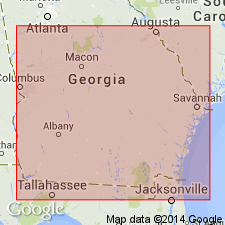
- Usage in publication:
-
- Tiger Leap Member
- Modifications:
-
- Named
- Biostratigraphic dating
- Dominant lithology:
-
- Sand
- Limestone
- AAPG geologic province:
-
- South GA-North FL sedimentary province
Summary:
Tiger Leap Member, lower member of Parachucla Formation of Hawthorne Group, here named in southeast GA for exposures at Tiger Leap Bluff on the Savannah River. Strata was originally assigned to Combahee phase by Sloan (1908) but are here included in the expanded and revised Parachucla Formation. Unit also corresponds to the lower part of the Alum Bluff Formation of Veatch and Stephenson (1911). Alum Bluff is restricted from GA in this report. At type area, unit consists of limestone, calcareous shelly sand, calcareous microfossiliferous sand, and noncalcareous, pebbly, prominently bedded, feldspathic sand; elsewhere includes dolostone and phosphatic sand and sandstone. Only the upper 7 ft (2 m) (noncalcareous portion) of the unit is exposed at Tiger Leap Bluff. A complete 72-ft section in the core Effingham 10 (GGS-3108), between the 75 and 147-ft intervals, 3.2 mi south of the bluff is designated the reference section and parastratotype. The Tiger Leap is present beneath most of the eastern GA Coastal Plain except for the coastal area and probably occurs under most of the Southeast GA Embayment area and the Gulf Trough. The southern limits of the member are unknown, but it appears to be absent in the Suwannee River area of northern FL. Disconformably overlies the Suwannee Limestone; underlies the Porters Landing Member (new name) of the Parachucla. Age is early Miocene (Aquitanian) based on planktonic Foraminifera.
Source: GNU records (USGS DDS-6; Reston GNULEX).
For more information, please contact Nancy Stamm, Geologic Names Committee Secretary.
Asterisk (*) indicates published by U.S. Geological Survey authors.
"No current usage" (†) implies that a name has been abandoned or has fallen into disuse. Former usage and, if known, replacement name given in parentheses ( ).
Slash (/) indicates name conflicts with nomenclatural guidelines (CSN, 1933; ACSN, 1961, 1970; NACSN, 1983, 2005, 2021). May be explained within brackets ([ ]).

